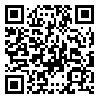Volume 34, Issue 134 (March 2022)
IJN 2022, 34(134): 18-31 |
Back to browse issues page
Download citation:
BibTeX | RIS | EndNote | Medlars | ProCite | Reference Manager | RefWorks
Send citation to:



BibTeX | RIS | EndNote | Medlars | ProCite | Reference Manager | RefWorks
Send citation to:
Matinpor A, Khanjari S, Mahdavi M, Anvari S, Haghani H. Using Air Cushion in the Prevention of Occipital Pressure Ulcer in Children Undergoing Heart Surgery. IJN 2022; 34 (134) :18-31
URL: http://ijn.iums.ac.ir/article-1-3320-en.html
URL: http://ijn.iums.ac.ir/article-1-3320-en.html
Using Air Cushion in the Prevention of Occipital Pressure Ulcer in Children Undergoing Heart Surgery
1- Department of Pediatric Nursing, School of Nursing and Midwifery, Iran University of Medical Sciences, Tehran, Iran.
2- Department of Pediatric Nursing, School of Nursing and Midwifery, Nursing Care Research Center, Iran University of Medical Sciences, Tehran, Iran. ,sed.khanjari@gamil.com
3- Shahid Rajaei Cardiovascular Training Center, Research and Treatment Center, School of Medicine, Iran University of Medical Sciences, Tehran, Iran.
4- Cardiovascular Training Center, Research and Treatment Center, Tabriz, Iran, Faculty of Medicine, Tabriz University of Medical Sciences, Tabriz, Iran.
5- Department of Medical Management and Information, Faculty of Management and Information, Iran University of Medical Sciences, Tehran, Iran.
2- Department of Pediatric Nursing, School of Nursing and Midwifery, Nursing Care Research Center, Iran University of Medical Sciences, Tehran, Iran. ,
3- Shahid Rajaei Cardiovascular Training Center, Research and Treatment Center, School of Medicine, Iran University of Medical Sciences, Tehran, Iran.
4- Cardiovascular Training Center, Research and Treatment Center, Tabriz, Iran, Faculty of Medicine, Tabriz University of Medical Sciences, Tabriz, Iran.
5- Department of Medical Management and Information, Faculty of Management and Information, Iran University of Medical Sciences, Tehran, Iran.
Abstract: (2470 Views)
Background & Aims: Congenital heart disease is one of the main causes of death in their first year of life. One of the most significant complications of surgery in these patients is pressure ulcers. The aim of this study was to determine the effect of using air cushion in the prevention of occipital pressure ulcer in children undergoing heart surgery.
Materials & Methods: The present study was a randomized clinical trial and 135 children undergoing open heart surgery aged 0 to 12 years referred to two cardiac centers in Tabriz and Tehran. They were randomly assigned to the intervention and control groups by continuous sampling during one year (September 2016- September 2017). The group of intervention used air cushions that has an air inlet and outlet pump and is filled and emptied by a pump alternately and creates 3 to 4 cm waves. This air cushion with dimensions of 30 to 40 cm waterproof and anti-allergy air cushion covered with a cotton cover. Data collection tools included: National Pressure Ulcer Advisor Panel and Braden Q. Chi-square, Fisher's exact test, independent t-test, Mann-Whitney and analysis of covariance were used to achieve the goals.
Results: The incidence of occipital pressure ulcer in the control group after surgery was 38.7%, the first day after surgery was 71% and the second day after surgery was 67.7%. However, in the intervention group no occipital pressure ulcer was observed in all periods after surgery. There was no significant difference in the scores of pressure ulcers in the preoperative times between the intervention and control groups (P<0.05), but after operation and the second day of surgery, the scores of pressure ulcers in the intervention group were significantly higher than the control group (P=0.002). This means that the pressure ulcer scores in the intervention group were better than the control group.
Conclusion: The use of air cushion appropriate to the size and weight of children is a suitable equipment to prevent occipital pressure ulcer in children undergoing open heart surgery.
Materials & Methods: The present study was a randomized clinical trial and 135 children undergoing open heart surgery aged 0 to 12 years referred to two cardiac centers in Tabriz and Tehran. They were randomly assigned to the intervention and control groups by continuous sampling during one year (September 2016- September 2017). The group of intervention used air cushions that has an air inlet and outlet pump and is filled and emptied by a pump alternately and creates 3 to 4 cm waves. This air cushion with dimensions of 30 to 40 cm waterproof and anti-allergy air cushion covered with a cotton cover. Data collection tools included: National Pressure Ulcer Advisor Panel and Braden Q. Chi-square, Fisher's exact test, independent t-test, Mann-Whitney and analysis of covariance were used to achieve the goals.
Results: The incidence of occipital pressure ulcer in the control group after surgery was 38.7%, the first day after surgery was 71% and the second day after surgery was 67.7%. However, in the intervention group no occipital pressure ulcer was observed in all periods after surgery. There was no significant difference in the scores of pressure ulcers in the preoperative times between the intervention and control groups (P<0.05), but after operation and the second day of surgery, the scores of pressure ulcers in the intervention group were significantly higher than the control group (P=0.002). This means that the pressure ulcer scores in the intervention group were better than the control group.
Conclusion: The use of air cushion appropriate to the size and weight of children is a suitable equipment to prevent occipital pressure ulcer in children undergoing open heart surgery.
Type of Study: Research |
Subject:
nursing
Received: 2020/04/3 | Accepted: 2022/02/20 | Published: 2022/03/1
Received: 2020/04/3 | Accepted: 2022/02/20 | Published: 2022/03/1
Send email to the article author
| Rights and permissions | |
 |
This work is licensed under a Creative Commons Attribution-NonCommercial 4.0 International License. |







